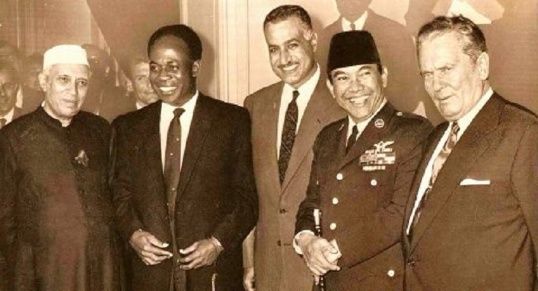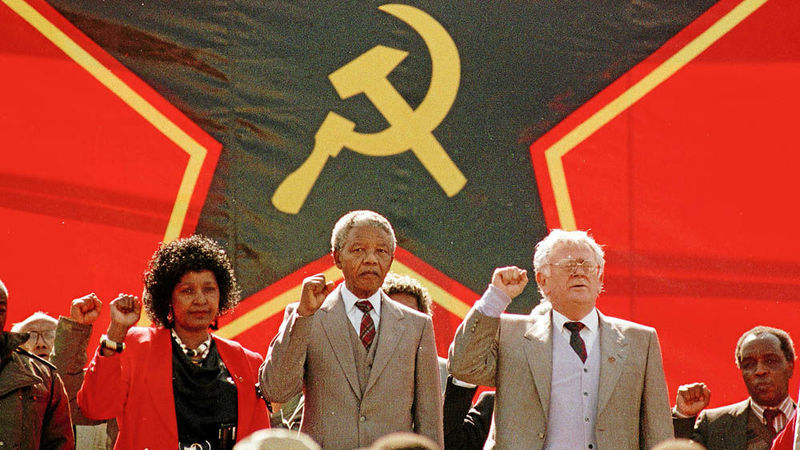These historically independent countries, "liberated" by Soviet Russian forces from their Axis occupiers, were effectively sealed off from the West. They were deprived of the opportunity to choose a government and economic system based on the will of the people as per the agreements of the Yalta and Potsdam conferences.
A few were permitted to have an "election", however only Communist candidates appeared on the ballot while in some cases votes were counted by pro-Communist officials, appointed by Soviet Russian political officers. As Stalin famously said, "I consider it completely unimportant who in the party will vote, or how; but what is extraordinarily important is this—who will count the votes, and how".
Although the four principal powers---France, England, Russia, and the U.S.--- had agreed on free and open elections, Soviet Russian forces quickly proceeded to flush out any nationalist, pro-democratic (including social democratic) or pro-capitalist supporters. All non-Communist newspapers and radio broadcasts were immediately shut down.
In lieu of a free and open democratic expression, Stalinism was imposed on the people. Any even suspected of opposing were arrested. A few were afforded the opportunity to "confess" their guilt through show trials and to have their families and friends publicly denounce them.
Most never went to trial. Instead, they were immediately detailed to the brutal work camps of the Gulag where, despite the length of their sentence, faced a life expectancy of no more than five years. Others were simply murdered. In short, one oppressive occupier merely replaced the other.However, what many people don't know was that the world didn't fall neatly into two competing ideological camps, Western capitalism on one hand and Communism on the other. There was a third alternative. It was called the Non-Aligned Movement (NAM). It sought a balancing act between the two great superpowers, the United States and its allies and the USSR and its supporters.
Formed in 1961, the Non-Alignment Movement (NAM) was the collective brainchild of Gamal Abdel Nasser of Egypt, Yugoslav President Josip Tito, India's Prime Minister Jawaharlal Nehru, Ghanaian President Kwame Nkrumah, and Indonesian President Sukamo.
The movement eventually expanded to encompass 120 countries. It represented 58% of the world's population (or about 4.57 billion people) along with 36.1% of the world's habitable areas. In terms of economic output, its member nations export roughly $4.499 trillion dollars in goods and services.
Among its agreed upon principals was the opposition of colonialism and imperialism, foreign aggression and occupation (militarily or economic), foreign domination, and any form of outside interference by a foreign nation or block of nations. It also opposed any form of apartheid. Its emphasis would be on mutual cooperation and support. The movement was designed to represent a center path which avoided the Soviet Bloc and Western Bloc.
With the fall of the USSR and end of the Cold War, the movement appeared adrift and without a political purpose. With only one world "superpower", it considered facing obsolescence like that predicted for NATO. However, that perception quickly changed as new post-Cold War blocks began to form. China's rapid economic expansion too proved to be powerful alternative to Western hegemony.As a result, NAM adapted to the changing political and economic events. While retaining a policy opposing economic and political neo-imperialism and colonialism and supporting peaceful co-existence and mutual co-operation, it expanded beyond trade to include support to improve access to quality education, a reduction in global poverty, opposition to social injustice and gender equality.
For example, all but two countries in Africa (Sudan and Western Sahara) are members of NAM. Nevertheless, half of the countries in Africa's Sub-Sahara have poverty rates of 35% or higher (the international poverty rate is subsisting on less than $1.90 per day). By 2030, half of world's population living in poverty will be in Africa, followed closely by South Asia. As an aside, about 689 million people currently live in extreme poverty with about 3.4 billion living on its edge.
NAM also reiterated its strong opposition to cultural homogenization or the grafting of foreign influence on native symbols, culture, dress, medicine and so forth while deliberately suppressing native language, values, traditions, or religion. What does this mean?
A few good examples would be the forced homogenization of a nation hell bent on the self-created myth of "manifest destiny" on the culture and beliefs of native peoples like 19th century America, or the British Empire's attempt to "civilize" India, and the Catholic Church's forced conversion of indigenous populations. Sadly, history is chalk full of other examples.
Operating under the umbrella of the United Nations, NAM has adopted policies such as self-determination of Puerto Rico and the Western Sahara, democratic reform of the UN's Security Council to make it more transparent and effective, broader expansion of technology to second and third tier nations, restructuring debt and trade agreements, and economic investment in poorer countries.Long term sustainability is also another major key goal for NAM members. This includes development of natural resources in a environmentally responsible fashion, as well as the development of sustainable housing, electricity, fresh water, and expanded healthcare.
Of course there has been criticism, especially from the West (and particularly the United States). Some of criticism pertains to ongoing internal conflicts along ethnic and religious lines and political corruption while some members are in conflict with each other (such as Iran and Iraq or India and Pakistan) in violation of NAM's founding principles. Other criticisms points to a policy of self-interest at the expense of fellow member states and a lack of defined objectives for both the short and long term development of NAM.
While one of the key principals of the Non-Aligned Movement has been gender equality, it's worth noting that none of its 31 chairmen since its establishment in 1961 has been a woman. Worse still is that several of its members deny even the most basic equality for women such as the right vote, hold public office, drive, own property, hold a job, or obtain an proper education.
Noncompliance with these archaic laws can in some instances result in public beatings or caning, fines, or even stoning. In a few countries, female genital mutation is tolerated (at least unofficially). Much the same can be said for the treatment of homosexuals. Doesn't say much for equality does it?
Lastly, the loudest complaint (which comes primarily from the U.S.) is that the Non-Aligned Movement has been especially harsh toward Western capitalism and yet lenient when it comes to Communism. Doesn't sound evenhanded does it? But when you consider that many of NAM chairmen have been Communist or Communist sympathizers, it makes sense that it would affect their credibility.Meanwhile, in a few of the member nations, political opposition groups are either restricted or outlawed while freedom of speech, religion, and assembly are curtailed (especially if its criticism of the government). Violators are often fined, tortured, imprisoned, and in some cases "disappeared".
Since these are predominately poorer countries, many feel they've been taken advantage of by the West, and there's likely some truth in this. Western countries have a long history of exploiting weaker nations. It's at the heart of colonialism (however, domestic "colonialism" is also to blame as one tribe or ethic group seeks to exploit a weaker one).
Today, in the era of growing neo-fascist corporate globalism, we have a new form of colonialism where governments are openly and covertly bribed (it doesn't sound so insidious if you think of it in terms of "corporate sponsorship"). This usually works since these corporations control not just the political parties, media, and finances of their country, but the domestic and foreign policies of their respective governments. It's all about control of and access to assets and resources.
So, while Neo-Cons on both sides are trying to rekindle a new Cold War, where does the Non-Aligned Movement go from here? Some see the movement as flawed from the beginning. They can't comprehend a non-aligned stance by any nation. Their political imagination is in black and white as if this was some playground game where you have to "pick a side".
It reminds me of America's deepening political abyss where Democrats and Republicans can't comprehend the non-partisan political stance of an Independent. Some will grudgingly "permit" Independents (who are the majority of voters) and third parties types the option of "leaning" Democrat or Republican as if they were closet partisans, which couldn't be further from the truth. This is especially true of the corporate media and pollsters.The fact of the matter is that the majority of nations today don't want a new Cold War. They don't want to be forced to align with a kleptocratic and yet fragile Russia, an imperialistic and unstable China, a fractured EU, or a failing American Empire (and they certainly don't want backwards theocratic state) Many nations are rethinking capitalism as much as they are reconsidering socialism or even Communism in its present form.
Perhaps too it's time to find a whole new system. One thing is for certain, no one system is right for everyone and that's why globalism will fail. Humanity, for all its technological arrogance, is still tribal, but that's how we're hardwired. We're also too self-serving, both individually and nationally.
Ultimately, we want what's best for us and damn the rest. That's why there are wars. It's also why we still have poverty on a global scale and millions starving in a world where 1.1% of the population controls nearly half of the world's wealth. The ruling oligarchy may own the oil and gas but the poor have the matches.
The Non-Aligned Movement, for all it's (many) flaws recognizes our tendency towards self-interest and thus conflict. However, despite political and economic ideologies, ethnic and religious divisions, agrees to find ways to accept these differences and try to work together as best as possible.
The era of the one size fits all Pax Americana has ended. Any attempt to put Humpty Dumpty Uncle Sam back together again will fail just as utterly as any attempt to reconstruct Cold War alliances. Meanwhile, the more China attempts to impose its particular flavor of despotism on its neighbors and trading partners, the more it will be rejected in favor of human freedom. That too is part of our nature for we are a rebellious species.At best we may see a world of loose regionalism and cooperation, but not at the expense of national interests or identity even if it's preservation means it balkanization to save some part of the original. Thus perhaps the Non-Aligned Movement may prove to be the best model to be emulated.
If you want to know more about this article's topic, please
check out the links below. If you enjoyed the article, please consider passing
it along to others and don't forget to subscribe. It's free! Lastly please
be sure to "like" us on whatever platform you use to read anotheropinionblog.com. It helps with the algorithms and keeps our articles
in circulation. Thank you!
Latin America and the New Non-Alignment
https://foreignpolicy.com/2022/12/23/latin-america-2022-nonalignment-world-cup-messi-migration/
Non-Aligned Movement
https://en.wikipedia.org/wiki/Non-Aligned_Movement
World Data: Member States of the Non-Aligned Movement
https://www.worlddata.info/alliances/non-aligned-movement.php
NTI: Non-Aligned Movement (NAM)
https://www.nti.org/education-center/treaties-and-regimes/non-aligned-movement-nam/
No cold war, please: How Europeans should engage non-aligned states
https://ecfr.eu/article/no-cold-war-please-how-europeans-should-engage-non-aligned-states/
The New Non-Aligned Movement
https://www.heritage.org/global-politics/commentary/the-new-non-aligned-movement






No comments:
Post a Comment